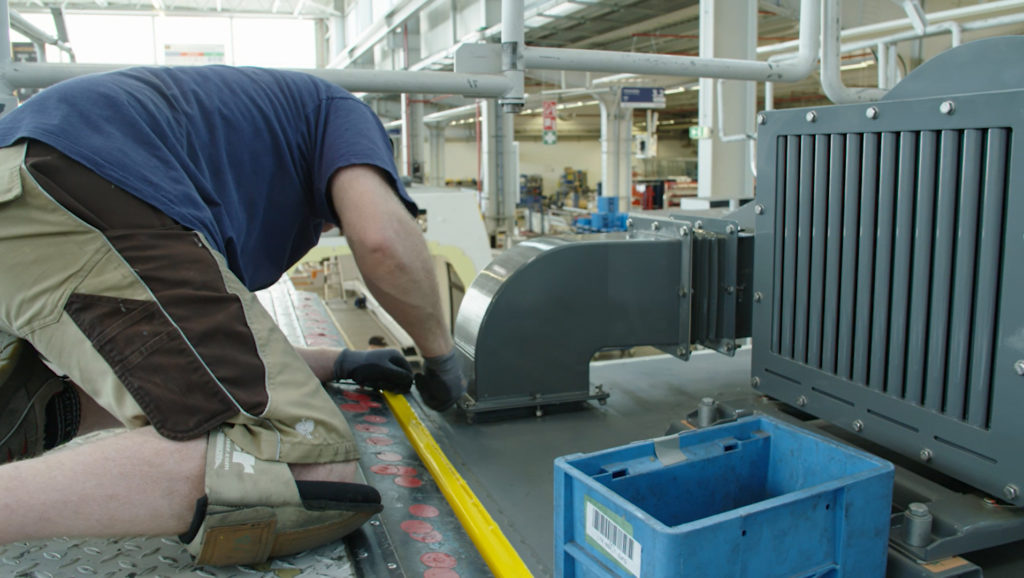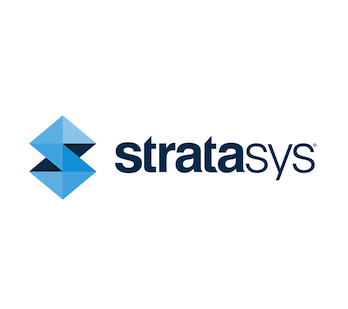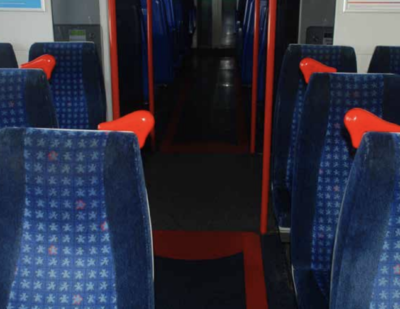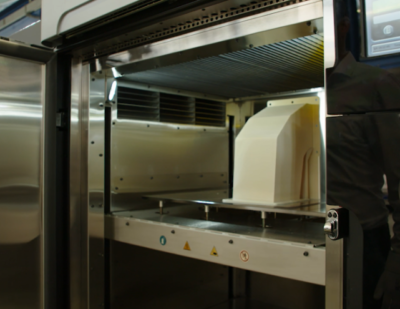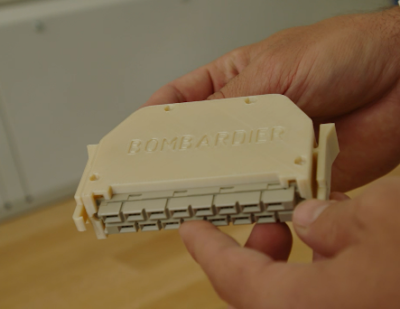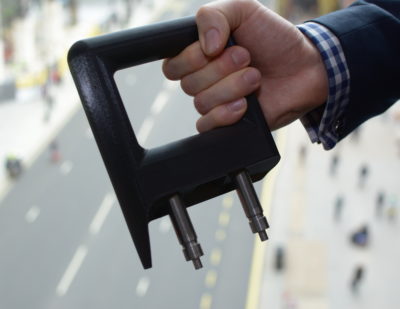In the next decade, additive manufacturing will become an indispensable part of leading rail transportation providers’ operations.
This is a bold claim and one that any reader would rightly be skeptical about, especially given that I work for Blueprint, a strategic consultancy focusing on 3D printing. However, over the last three decades, the technology has matured, and the range of possible applications has grown massively.
3D printing is now an industrial-grade tool that rail transportation providers can and should be leveraging to secure their supplies of service parts, create tools that help maintenance and operations, and to enhance safety and customer experience.
I’m not suggesting that a 3D printer will replace your entire parts inventory. There are many parts of a locomotive or passenger coach that simply aren’t feasible to 3D print. However, in the last few decades, the technology has come a long way. We now can print in everything from metals, to polymers that meet fire, smoke, and toxicity requirements, to ceramics and metamaterials. And the ever-increasing ecosystem of machines, service providers, and design tools means that more applications become both technically and economically viable daily.
One of the unique aspects of rail is that equipment is in service for a long time – often 30 to 40 years and beyond. As the decades roll by, keeping trains running and in good repair requires service parts. Unfortunately, parts go out of production, suppliers go out of business, and spare parts get expensive. Often, operators must absorb tooling costs to re-manufacture parts. Sometimes, operators must get creative, producing parts in house…I’ve even heard of operators turning to eBay to source parts!
The Sweet Spot for Additive Manufacturing: Low Volume, High Value, Long Lead-Time Parts
Often, the sweet spot for additive manufacturing is in low-volume, high value, long lead-time parts. Why? 3D printing reduces lead times and allows you to avoid the high up-front costs of traditional manufacturing: supply chain, tooling, and setup.
On the cost side, 3D printing often eliminates tooling and setup costs associated with traditional manufacturing. These lowered fixed costs mean that production at low volumes becomes economically viable. The graph below shows visually why this happens.
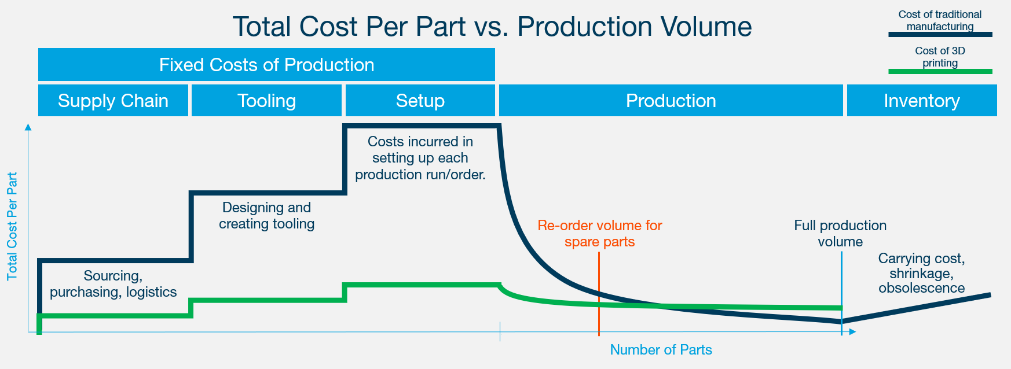
There’s a time benefit too: Since additive manufacturing doesn’t require setup or tooling, 3D-printed parts can often be produced with lead times in days versus weeks or months for traditional manufacturing.
For a more detailed exploration of the value of additive manufacturing for spare parts, check out my webinar about the business case for 3D printing spare parts.
How Does This Translate into Rail?
Given that 3D printing sweet spot in low-volume, high-value, low cost spare parts, it should be clear that there is some opportunity for 3D printing to make an impact in rail maintenance, but what does that look like at a tactical level?
Based on our engagements with clients, Blueprint has identified four categories of cases where additive manufacturing is poised to add the most value to rail and the value drivers associated with each use case:
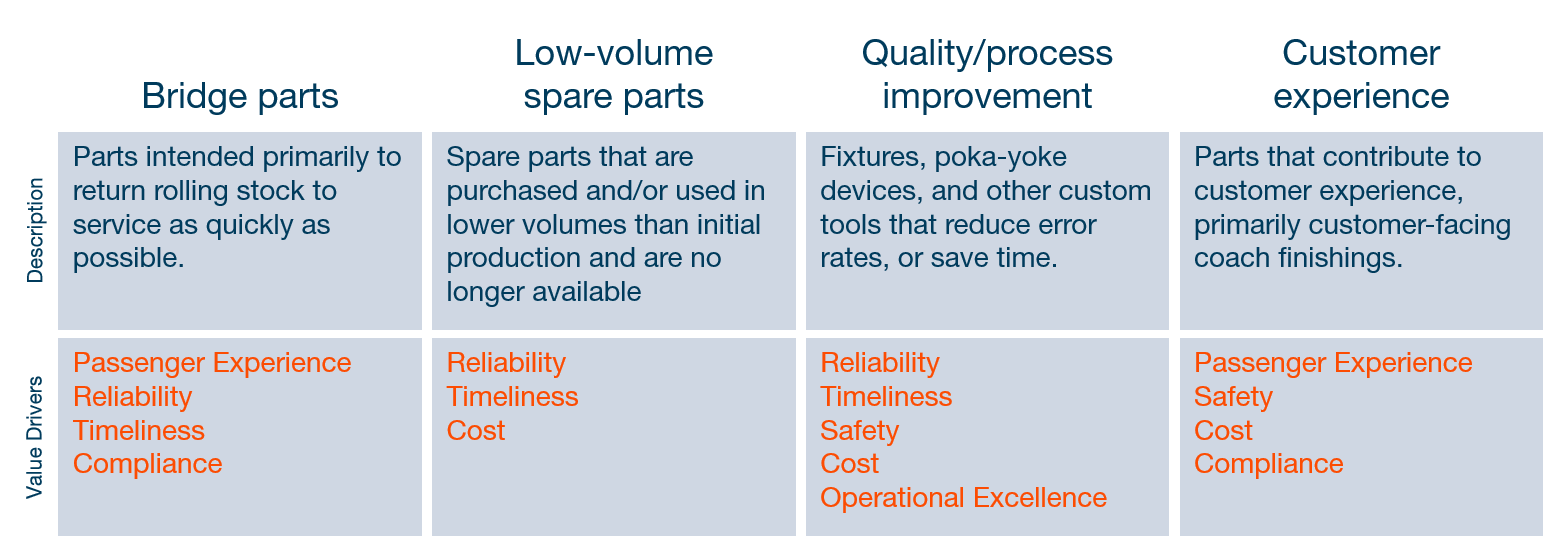
Bridge parts – In rail, the cost of having a coach out of service is massive. During a recent engagement, Blueprint found that the direct costs of having a single commuter rail trainset out of operation were around $20,000/day. When the financial penalties add up quickly, having the ability to quickly produce replacement parts in house is critical. In one case, we found 3D printing a single part saved our client over $1.5 million, because the alternative would keep a trainset out of service for 16 weeks while they waited for a replacement part.
Low volume spare parts – It’s no secret that everything costs more in rail, but why is this? In order to service rolling stock for 30+ years, inventories of spare parts need to be curated, maintained, and paid for. Not only is stocking parts for 30 years expensive in terms of carrying costs, shrinkage, and spoilage, but inevitable there will be some parts that go out of stock. When spare parts are no longer available in inventory, they must be recreated, either as one-off parts from a fabrication shop or by retooling for a limited run production. This is expensive and causes massive lead times. Having the ability to 3D print toolsets can enable you to create many of these parts in-house, with lower lead times and at a lower cost than traditionally sourced parts.
Quality/Process improvement – World class manufacturers employ several tools to mistake-proof their operations, ensuring that first pass yield (a common measure of manufacturing quality) is high and that rework is kept to a minimum. These can be anything from a drill guide, to a fit-up check device, to redesigning parts to be keyed so they can only be installed correctly. This trend has been slow to take hold in rail, but that doesn’t mean there isn’t opportunity. Holders for common toolsets can ensure that loss and shrinkage is kept to a minimum. Work guides and fixturing devices can be employed to ensure that everything from decals to custom locking devices can ensure a more robust lockout/tag-out safety program.
Customer experience – Between ridesharing, scooters, hourly car rental, and bicycling sharing, everyone has more options for urban mobility today than ever before. Having vehicles, stations, and equipment in good repair goes a long way toward providing the kind of customer experience that incents riders to choose public transit over other options. Too often, traditional supply chains can’t provide the support required to keep equipment in good repair, leaving transportation providers choosing between repairing or removing non-essential cosmetic parts. In many cases, 3D printing provides a feasible option for obtaining the parts needed to keep vehicles in good repair.
What Does the Future Hold?
Imagine a world in which your trainset came with a digital inventory of spare parts. Those spare parts could be produced by any number of fabrication shops. Lead times would be hours or days instead of weeks or months. Inventory could be kept to a minimum. And part availability could be guaranteed in perpetuity. Siemens seems to have imagined that future, given their investment in creating a digital inventory of spare partscreating a digital inventory of spare parts.
But you don’t have to wait for your OEMs to get on board before taking advantage of a digital inventory. Blueprint has helped a number of clients develop a digital inventory of spare parts that they can produce in-house.
How to Get Started?
Guaranteed part availability. Lower costs. Better quality. Improved safety.
All of this sounds appealing, but the journey toward building an additive manufacturing capability won’t happen overnight. Here are a few ideas to get started:
Understand the technology. Before starting to print or consider a printer purchase, you should understand what the capabilities of additive manufacturing are, what the technology can do, and what materials are out there. Have someone with deep experience in additive manufacturing provide an overview of the tools, technologies, and what is available.
Generate ideas. Next, assemble an additive manufacturing task force. Include participants from supply chain, engineering, maintenance, program management, and operations. Generate ideas and concepts for using additive manufacturing in a workshop format. Work with an expert in additive to vet those ideas for feasibility.
Develop your engineering capability. Finally, find additive manufacturing engineering capability. If you have engineering and design capabilities in-house, upskilling on design for additive manufacturing is a must. Often a service bureau or additive consultancy can help provide you with this service. Alternatively, find a partner knowledgeable about design for additive who can handle design for your organisation.
Of course, these are only the first few steps to finding value in additive with these parts. Remember, this is a marathon, not a sprint. The most important thing is to get started; the sooner your organization starts exploring additive, the sooner you’ll realize that the promise of 3D printing in rail and transportation is here, today. It’s time to get on board.
Ready to get on board with 3D printing? See how the Blueprint team can help – or explore the newly announced Stratasys Rail Solutions!
Blog by Kunal Mehta.
